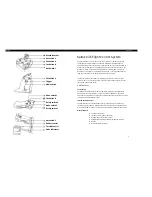
© National Instruments
|
4-9
Hardware-timed generations have several advantages over software-timed acquisitions:
•
The time between samples can be much shorter.
•
The timing between samples is deterministic.
•
Hardware-timed acquisitions can use hardware triggering.
Hardware-timed DO operations on the cDAQ controller must be buffered.
Buffered Digital Output
A buffer is a temporary storage in computer memory for generated samples. In a buffered
generation, data is moved from a host buffer to the cDAQ controller onboard FIFO before it is
written to the C Series module(s).
One property of buffered I/O operations is sample mode. The sample mode can be either finite
or continuous:
•
Finite
—Finite sample mode generation refers to the generation of a specific,
predetermined number of data samples. After the specified number of samples is written
out, the generation stops.
•
Continuous
—Continuous generation refers to the generation of an unspecified number of
samples. Instead of generating a set number of data samples and stopping, a continuous
generation continues until you stop the operation. There are three different continuous
generation modes that control how the data is written. These modes are regeneration,
onboard regeneration, and non-regeneration:
–
In regeneration mode, you define a buffer in host memory. The data from the buffer is
continually downloaded to the FIFO to be written out. New data can be written to the
host buffer at any time without disrupting the output.
–
With onboard regeneration, the entire buffer is downloaded to the FIFO and
regenerated from there. After the data is downloaded, new data cannot be written to
the FIFO. To use onboard regeneration, the entire buffer must fit within the FIFO size.
The advantage of using onboard regeneration is that it does not require communication
with the main host memory once the operation is started, which prevents problems that
may occur due to excessive bus traffic or operating system latency.
Note
Install parallel DO modules in slots 1 through 4 to maximize accessible FIFO
size because using a module in slots 5 through 8 will reduce the accessible FIFO size.
–
With non-regeneration, old data is not repeated. New data must continually be written
to the buffer. If the program does not write new data to the buffer at a fast enough rate
to keep up with the generation, the buffer underflows and causes an error.
Digital Output Triggering Signals
Digital output supports two different triggering actions: DO Start Trigger and DO Pause Trigger.
















































